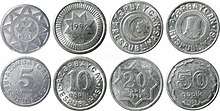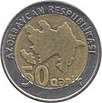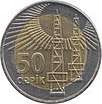Azerbaijani manat
The manat (code: AZN ; symbol: ₼) is the currency of Azerbaijan. It is subdivided into 100 qəpik.
| Azerbaijani manat | |||||
|---|---|---|---|---|---|
| Azərbaycan manatı (Azerbaijani) | |||||
| |||||
| ISO 4217 | |||||
| Code | AZN | ||||
| Denominations | |||||
| Subunit | |||||
| 1/100 | qəpik | ||||
| Plural | The language(s) of this currency do(es) not have a morphological plural distinction. | ||||
| Symbol | ₼ | ||||
| Banknotes | 1, 5, 10, 20, 50, 100, 200 manat | ||||
| Coins | 1, 3, 5, 10, 20, 50 qəpik | ||||
| Demographics | |||||
| User(s) | |||||
| Issuance | |||||
| Central bank | Central Bank of Azerbaijan | ||||
| Website | www | ||||
| Valuation | |||||
| Inflation | 3% H1 2018 | ||||
| Source | MENAFN | ||||
| Method | CPI | ||||
The Azerbaijani manat symbol, ₼ (![]()
Etymology
The word manat derived from the word "Moneta" (Latin Monēta) In Roman mythology, was a title given to two separate goddesses: the goddess of memory. The latter's name is a source of numerous words in English and the Roman languages, including the words "money" and "mint". Manat was also the designation of the Soviet ruble in both the Azerbaijani and Turkmen languages.
First manat, 1919–1923
The Azerbaijan Democratic Republic and its successor the Azerbaijani Soviet Socialist Republic issued their own currency between 1919 and 1923. The currency was called the manat (منات) in Azerbaijani and the ruble (рубль) in Russian, with the denominations written in both languages (and sometimes also in French) on the banknotes. The manat replaced the first Transcaucasian ruble at par and was replaced by the second Transcaucasian ruble after Azerbaijan became part of the Transcaucasian Soviet Federal Socialist Republic. No subdivisions were issued, and the currency only existed as banknotes.
Banknotes
The Democratic Republic issued notes in denominations of 25, 50, 100, 250 and 500 manat, whilst the Soviet Socialist Republic issued notes in denominations of 5; 100; 1,000; 5,000; 10,000; 25,000; 50,000; 100,000; 250,000; 1 million and 5 million manat.
Second manat, 1992–2006
The second manat was introduced on 15 August 1992.[1] It had the ISO 4217 code AZM and replaced the Soviet ruble at a rate of 10 rubles to 1 manat.
From early 2002 to early 2005, the exchange rate was fairly stable (varying within a band of 4770–4990 manat per US dollar). Starting in the spring of 2005 there was a slight but steady increase in the value of the manat against the US dollar; the reason most likely being the increased flow of petrodollars into the country, together with the generally high price of oil on the world market. At the end of 2005, one dollar was worth 4591 manat. Banknotes below 100 manat had effectively disappeared by 2005, as had the qəpik coins.
Coins

Coins were issued in denominations of 5, 10, 20 and 50 qəpik, dated 1992 and 1993. Although brass and cupro-nickel were used for some of the 1992 issues, later issues were all in aluminium. These coins were rarely used in circulation.
Banknotes
The following banknotes were issued for this currency
- 1, 5, 10, 250 manat (all first issued on 15 August 1992)
- 50, 100, 500, 1000 manat (all first issued in early 1993)
- 10,000 manat (first issued in August 1994)
- 50,000 manat (first issued in May 1996)
Banknotes with denominations from 1 to 250 manat featured Baku's Maiden Tower.
Third manat, 2006
On 1 January 2006, a new manat (ISO 4217 code AZN, also called the "manat (national currency)") was introduced at a ratio of 1 new manat to 5,000 old manat. From 1 October 2005, prices were indicated both in new manat and in old manat to ease transition. Coins denominated in qəpik, which had not been used from 1993 onward due to inflation, were reintroduced with the re-denomination. The former manat (ISO code 4217 AZM) remained valid through 31 December 2006.[2]
Symbol
The new banknotes and Azerbaijani Manat symbol, ₼, were designed by Robert Kalina in 2006, and the symbol was added to Unicode (U+20BC) in 2013, after failed addition proposals between 2008 and 2011.[3] The final Azerbaijani Manat symbol design was inspired by the design of the Euro sign (€), based on an initial proposal by Mykyta Yevstifeyev,[4] and resembles a single-bar Euro sign rotated 90° clockwise. The manat symbol is displayed to the right of the amount.
Coins
Coins in circulation are 1, 3, 5, 10, 20 and 50 qəpik. Most coins closely resemble the size and shape of various euro coins. Most notably the bimetallic 50 qəpik (similar to the €2 coin) and the 10 qəpik (Spanish flower, like the 20 euro cent coin). Coins were first put into circulation during January 2006 and do not feature a mint year.
| Image | Value | Technical parameters | Description | |||||
|---|---|---|---|---|---|---|---|---|
| Obverse | Reverse | Diameter | Mass | Composition | Edge | Obverse | Reverse | |
 |
 |
1 qəpik | 16.25 mm | 2.8 g | Copper-plated steel | Plain | Map of Azerbaijan, country name, value | Traditional musical instruments, denomination left |
 |
 |
3 qəpik | 18 mm | 3.45 g | Smooth with a groove | Books and quill, denomination above | ||
 |
 |
5 qəpik | 19.75 mm | 4.85 g | Reeded | The Maiden Tower, denomination below | ||
 |
 |
10 qəpik | 22.25 mm | 5.1 g | Brass-plated steel | Smooth with seven indentations | Ancient military helmet of the region of Nagorno-Karabakh, denomination left | |
 |
 |
20 qəpik | 24.25 mm | 6.6 g | Segmented reeding | Spiral staircase, Geometry & Geometrical symbols, denomination left | ||
 |
 |
50 qəpik | 25.5 mm | 7.7 g | Bi-Metallic Brass-plated steel center in Stainless Steel ring | Reeding over lettering (AZƏRBAYCAN RESPUBLIKASI) | Two oil wells, denomination left | |
Banknotes
Banknotes in circulation are 1, 5, 10, 20, 50, 100, and 200 manat. They were designed by Austrian banknote designer Robert Kalina, who also designed the current banknotes of the euro and the Syrian Pound. The notes look quite similar to those of the euro and the choice of motifs was inspired by the euro banknotes.
In 2009 the Azərbaycan Milli Bankı (National Bank of Azerbaijan) was renamed the Azərbaycan Respublikasının Mərkəzi Bankı (Central Bank of Azerbaijan). In 2010, the 1-manat banknote was issued with the new name of the issuing bank, in 2012 a 5-manat banknote was issued with the new name of the issuing bank and in 2017 a 100-manat banknote dated 2013 was issued with the new name of the issuing bank.
In 2011 Azerbaijan's Ministry of Finance announced it was considering to issue notes of 2 and 3 manat as well as notes with values larger than 100 manat.[5] In February 2013 the Central Bank of Azerbaijan announced it would not introduce larger denomination notes until at least 2014.[6]
In 2018, a 200-manat banknote was issued to commemorate Heydar Aliyev's 95th birthday.[7]
| Image | Value | Dimensions | Main Color | Description | Year | ||
|---|---|---|---|---|---|---|---|
| Obverse | Reverse | Obverse | Reverse | ||||
 |
 |
1 ₼ | 120 × 70 mm | Grey | Theme: Culture Azerbaijani folk music instruments (daf, kamancheh, tar) |
Ornaments of ancient Azerbaijani carpets | 2005 |
 |
 |
2009, 2017 | |||||
 |
 |
5 ₼ | 127 × 70 mm | Orange | Theme: Writing and literature Ancient writers, poets, and books from Azerbaijan, with a written excerpt of the national anthem and letters from the contemporary Azerbaijani alphabet |
Rock drawings of Gobustan, samples of Old Turkic script | 2005 |
 |
 |
2009, 2017 | |||||
 |
 |
10 ₼ | 134 × 70 mm | Teal | Theme: History Old Baku, the Palace of the Shirvanshahs and the Maiden Tower against a background of the Icheri Sheher wall |
Ornaments of ancient Azerbaijani carpets | 2005 |
 |
 |
2018 | |||||
 |
 |
20 ₼ | 141 × 70 mm | Green | Theme: Karabakh Signs of power (a sword, a helmet and a shield) |
Symbol of peace (harybulbul) | 2005 |
 |
 |
50 ₼ | 148 × 70 mm | Yellow | Theme: History and future Youth, stairs (as a symbol of progress), the sun (as a symbol of force and light) and chemical and mathematical symbols (as signs of science) |
Ornaments of ancient Azerbaijani carpets | 2005 |
 |
 |
100 ₼ | 155 × 70 mm | Mauve | Theme: Economy and development Architectural symbols from antiquity up to today, the manat currency symbol (₼) and symbols of economic growth |
Ornaments of ancient Azerbaijani carpets | 2005 |
 |
 |
2013 | |||||
 |
 |
200 ₼ | 160 × 70 mm | Blue | Theme: Modern architecture The Heydar Aliyev Center, Baku |
Ornaments of ancient Azerbaijani carpets | 2018 |
Exchange rates
- Before Feb 2015: $1 = 0.8 AZN
- Feb - Dec 2015: $1 = 1.05 AZN
- Dec 2015 - Apr 2017: Free floating
- May 2017 onwards: $1 = 1.7 AZN
| Current AZN exchange rates | |
|---|---|
| From Google Finance: | AUD CAD CHF EUR GBP HKD JPY USD RUB TRY GEL |
| From Yahoo! Finance: | AUD CAD CHF EUR GBP HKD JPY USD RUB TRY GEL |
| From XE.com: | AUD CAD CHF EUR GBP HKD JPY USD RUB TRY GEL |
| From OANDA: | AUD CAD CHF EUR GBP HKD JPY USD RUB TRY GEL |
| From fxtop.com: | AUD CAD CHF EUR GBP HKD JPY USD RUB TRY GEL |
See also
- 1 manat
- 5 manat
- 10 manat
- Central Bank of Azerbaijan
- Turkmenistan manat
- Economy of Azerbaijan
- Banking in Azerbaijan
References
- National Bank of Azerbaijan. "History of the National Bank of Azerbaijan". Retrieved 2006-12-30.
- "Currency codes". Interinstitutional style guide. European Union. 7 January 2014.
- Aliyev, Rustam (Jun 18, 2013). "Azeri Manat symbol is coming to Unicode (U+20BC)". Code.az.
- Pentzlin, Karl (2013-06-10). "Proposal to add the currency sign for the Azerbaijani Manat to the UCS" (PDF) (PDF).
- Trend.az (17-11-2011). Available at http://www.trend.az/capital/business/1958468.html
- Trend.az (26-02-2013). Available at http://www.trend.az/capital/business/2123837.html
- "Archived copy". Archived from the original on 2018-10-16. Retrieved 2018-05-25.CS1 maint: archived copy as title (link)
External links
- Der Standard article on the redenomination (in German)
- Azerbaijan Manat: Catalog of Banknotes
- Azerbaijan International. Azerbaijan's New Manats: Design and Transition to a New Currency
- Catalog of Azeri coins and banknotes
- Coins of Azerbaijan at CISCoins.net
- The banknotes of Azerbaijan (in English, German, and French)


